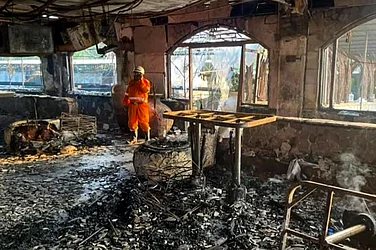Bantony Castle, the 143-year-old British-era landmark, has come alive once again with the newly launched ‘Light and Sound show’ – an immersive multi-media portrayal of Shimla’s momentous history, the hill town is set for a unique story-telling experience – the first of its kind in the post-Colonial history of Shimla.
“As the years moved on, and I aged, there were numerous additions to my character,” Shimla-born actor Anupam Kher’s voice rings the ears to recapture Bantony Castle‘s origin and its acclaimed history.
The sound and sparkling immersive images keep rolling as “Bantony” unfolds pages of Shimla’s history, its journey through centuries when Shimla was declared as the summer capital of erstwhile British rule in 1864.
In 1903, a rail line was constructed between Kalka and Shimla which now enjoys the status of a UNESCO World Heritage site.
In the words of Raaja Bhasin, noted Shimla historian and script-writer for Bantory’s “Light and Sound” show: “The elements of post-colonial hangover lingered over Shimla even as distinction still remains clear between ‘Indian heritage’ and Colonial landmarks or footprints”.
The next move on Bantony Castle is going to be more fascinating if the plans prepared by the state’s Department of Language, Art and Culture (LAC), the current custodian of the sprawling property, is any indication.
Take a walk through what Shimla has given to history. This is going to be showcased in the two-storey magnificent 143-year-old Bantony Castle, once a summer palace of the Maharaja of Sirmaur, built in the 19th century.
The main building is a two-storey structure constructed in the mock Tudor Style, part chalet and crowned with a sloping roof with mini-towers.
“We are going to have a city museum, a first-of-its-kind digitised art gallery. The main section will be in Shimla covering all its historical aspects viz landmarks, places, monumental buildings, events which happened in Shimla as a prelude to India’s independence, visit of top freedom fighters like Mahatma Gandhi, Pandit Jawahar Lal Nehru and talks/ round table conferences and also historic Simla Agreement signed on July 02, 1972, between Indira Gandhi and Zulfiqar Ali Bhutto,” Rakesh Kanwar, secretary LAC told Outlook.
There will be a section relating to Shimla’s literary history, famous poets, writers, painters and theatre personalities. Not to miss, the names and profiles of Rabindranath Tagore, Rudyard Kipling, Krishna Sobti, Amrita Shergil, Kushwant Singh, Prem Chopra, Anupam Kher and Padma awardee Hindi novelist and translator Nirmal Verma, whose book “Lal Teen ki Chhat” (1974) became most popular literary work related to Shimla.
He is credited as being one of the pioneers of the Nai Kahani (New Story) literary movement of Hindi literature, wherein his first collection of stories, Parinde (Birds) is considered its first signature.
In his career spanning five decades and various forms of literature from stories to travelogues and essays, he penned five novels, eight short-story collections and nine non-fiction books.
Nirmal Verma was born on April 3, 1929, in Shimla where his father worked as an officer in the Civil and Services Department of the British Indian Government.
Others to join the list of such figures include Emily Eden, a British writer, who stayed in Shimla, Master Madam – a Shimla-born Indian great singer (also called Child Prodigy), who died at the young age of 15, Manohar Singh, a popular Indian theatre actor, Vijay Kashayp, popular actor, known for his role in films like Gandhi and role in Doordarshan TV series Tenali Rama, Krishan Khanna, a painter of his repute and Mohan Rakesh, one the pioneers of the ‘Nai Kahani’ literary movement of the Hindi literature in India, who wrote the first modern Hindi play, Ashadh Ka Ek Din.
“Our effort is to introduce Himachal Pradesh, its culture, art and handicrafts besides the rich diversity of the land through the story of Shimla and Bantony under one roof” Kanwar says.
The story of Bantony in itself is highly momentous.
“Who am I? Many of you don’t know me, my glorious past. As I stand tall before you, raised from the rubble, today will take you through my momentous journey. Hello, I am Bantony!”
This is how storytelling begins here.
The restoration of Bantony happened after the government led by Virbhadra Singh acquired the property in 2016-17, making its private owners agree to a deal to develop the place as a heritage cultural centre, because of its architectural grandeur and heritage value.
“Bantony Castle will be a new international attraction because of its history and the kind of facelift it has undergone, during the past five-six years of its restoration piece by piece” says Mukesh Agnihotri, state’s deputy Chief Minister.
Located on Bantony Hill, named after Governor-General Lord Bentinck. The building is said to have been designed by T.E.G Cooper under the watchful eye of Raja Surender Bikram Prakash and before its construction began in 1880, the site had a cottage belonging to Captain A. Gordon, which housed army officers.
During the two World Wars, the rulers of Sirmaur allowed the colonial Government to use the premises for military purposes.
During World War II, here lay the Prisoner of War section attached to All India Radio for handling messages of mostly Italian prisoners interred at Yol, near Dharamshala. Just after Independence, the respected newspaper “The Tribune” which had been based in Lahore began functioning here till it shifted to Chandigarh, which is a significant part of the history.
"Just before the Independence of India, I passed into the hands of the Maharaja of Darbhanga. In 1957-58, Maharaja Sir Kameshwar Singh of Darbangha gave the property on rent to the Punjab Government and various wings initially, the Punjab, and later, the Himachal police were based here for several years. The Police Officers’ Mess was also located on the premises," Anupam Kher narrates.
While still with the police, in 1968, the estate was purchased by the prominent local business family of Ram Krishan and Sons. Himachal government acquired this nineteen-thousand square metre estate and structures in 2017, to create the elaborate complex that Bantony now houses.


























